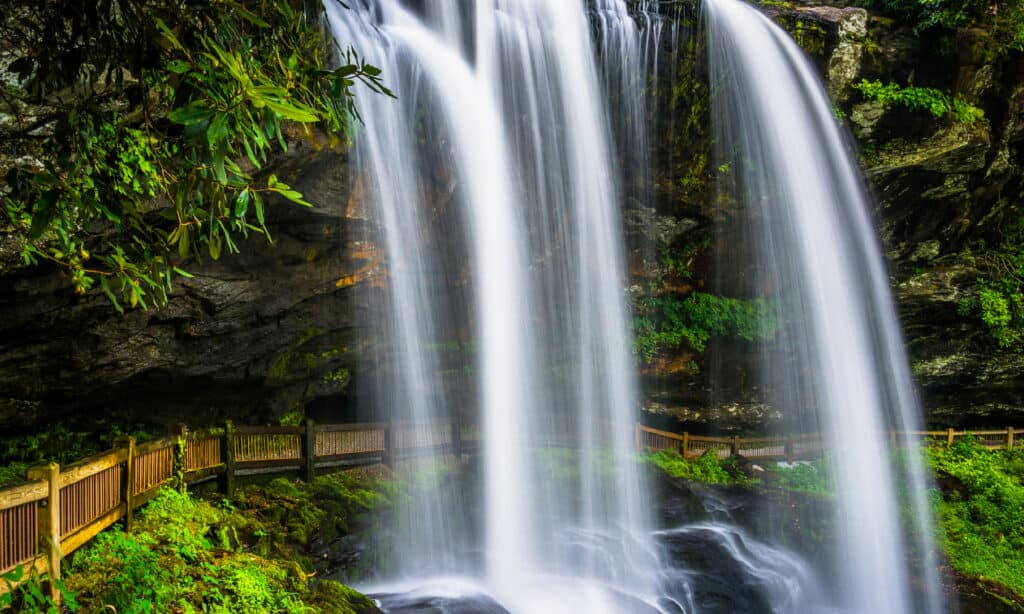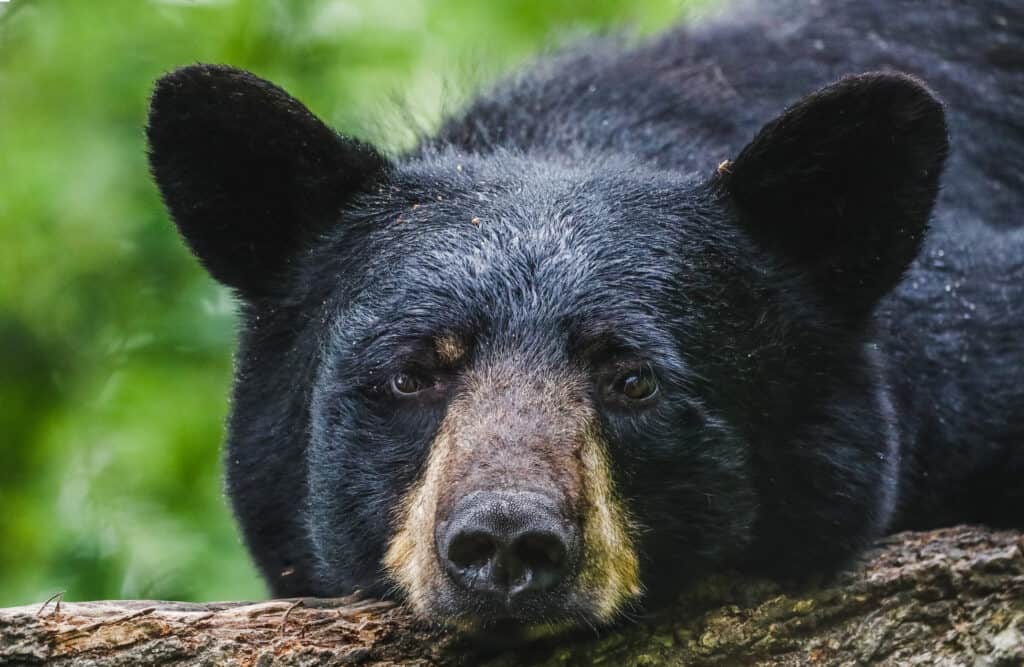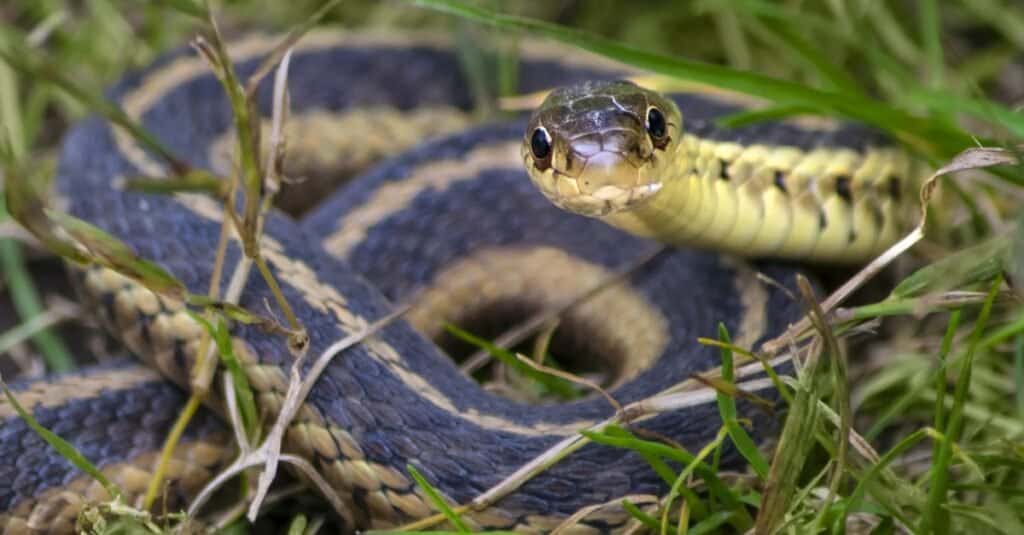North Carolina is one of the most ecologically diverse states in America. With forest lands covering an area of more than 18.3 million acres, the state ranks fourth on the list of states with the highest acreage of forested lands. More than half of North Carolina is covered by forests. Expectedly, forestry is the second-largest industry in the state. However, the forests in North Carolina also contribute to conservation efforts as they are home to a wide variety of wildlife in different habitats. Of the four national forests in North Carolina, one is the largest. Read on to discover all about this forest, including its size, wildlife, and other interesting facts.
The Largest Forest in North Carolina – Nantahala National Forest

The Nantahala National Forest covers an area of about 531,270 acres.
©iStock.com/Jon Bilous
North Carolina has 1.25 million acres of forested public land. The rest of the forested lands in the state are under non-industrial private ownership. North Carolina’s public lands include four National Forests that stretch from the mountains to its coast.
The largest forest in North Carolina is the Nantahala National Forest. Perched in the sprawling mountains and valleys of Southwestern North Carolina, the Nantahala National Forest covers an area of about 531,270 acres. The forest range stretches from Lone Bald in Jackson County at an elevation of about 5,800 feet to the Hiwassee River in Cherokee County at an elevation of 1,200 feet above sea level. Nantahala is under the control of the United States Forest Service. The forest is divided into three ranger districts: Tusquitee, Cheoah, and Nantahala.
Name and History of the Largest Forest in North Carolina
The Nantahala Forest was established on January 29, 1920, by President Woodrow Wilson under the authority of the 1911 Weeks Act. The name “Nantahala” comes from the Cherokee phrase for “land of the noonday sun.” The name is a reference to the area’s landscape, which keeps the sun from reaching the valley floor until midday.
The Cherokee tribe and their indigenous ancestors have lived in Nantahala for thousands of years, and the territory is considered by many to be part of their original homeland. Before the law that established the forest was enacted, the lands in the region were occupied by logging companies. After the Weeks Act was passed, the government purchased most of the lands in the area. However, a few private lands still remain scattered throughout the Nantahala Forest area.
Where is the largest Forest in North Carolina Located on a Map?
Located in the mountains of Southwestern North Carolina, the Nantahala National Forest is the largest forest in the state – covering an area of about 531,270 acres. The forest range stretches from Lone Bald in Jackson County to the Hiwassee River in Cherokee County. It is about an hour and a half drive southwest of Asheville, North Carolina.
Wildlife in the Nantahala National Forest
Thanks to its immense size, the Nantahala National Forest serves as a habitat for different mammals, birds, reptiles, and amphibians. Visitors can hunt some of the wildlife in Nantahala as long as they’re in the permitted region in the national forest. According to the US forest service, big and small game hunting in Nantahala can take place in the following areas: Tsali Recreation Area, Standing Indian Campground, Nantahala Ranger District, and Hurricane Creek Horse and Primitive Campground. Some of the most popular animals in the Nantahala National Forest are:
White-Tailed Deer

You can find white-tailed deer in the Nantahala National Forest.
©Tom Reichner/Shutterstock.com
The white-tailed deer, commonly known as the Virginia deer, is a medium-sized deer indigenous to North America, Central America, and South America. White-tailed deer adults have rusty brown coats throughout the warmer months. In the winter, the color becomes more muted. Bucks, the male deer species, are easily identified throughout the warmer months of the year thanks to their impressive antlers. The deer gets its name from the white underside of its tail, which it flashes and wags during potentially dangerous times.
Black Bear

The American black bear has the widest distribution.
©iStock.com/Mandy Fuller Photography
The Nantahala Forest is home to medium-sized bear species like the American black bear. Also called the black bear, this bear species has the widest distribution and is the smallest on the continent. Typically, a black bear would have a black, shaggy coat. The average black bear measures between four and seven feet in length from nose to tail and stands between two and three feet tall at the shoulders. The eyes are small with rounded ears. The snout is long and brown, and the tail is short.
Mountain Lion
Another popular animal within the largest forest in North Carolina is the massive mountain lion. It has the widest range of any big wild terrestrial animal in the Western Hemisphere, stretching from the Yukon in Canada to the Southern Andes in South America. Adaptable, sneaky, and isolated, mountain lions are a unique species. Although sightings of these nocturnal cats in the forest are uncommon, they most likely reside in the forest highlands.
Bobcat
The bobcat is a medium-sized North American cat that is also known as the red lynx. It gets its name from the stubby, black-tipped tail and the black bars on its forelegs. It’s a versatile predator that lives in a wide variety of habitats in the forest.
Coyote

The coyote is often mistaken for a
German shepherd
.
©Mircea Costina/Shutterstock.com
Coyotes are canines closely related to wolves and foxes. The coyote is often mistaken for a German shepherd or a collie due to its pointed ears, slim nose, and drooping bushy tail. Although most coyotes are a shade of grayish brown with some rusty highlights around the forehead and ears, their fur may actually range in hue from silvery gray to jet black. Typically, there is a black apex to the tail. They have yellow eyes instead of the usual brown found in domestic canines.
River Otter
The North American river otter, also known as the northern river otter and river otter, is a semi-aquatic mammal that may be found only in the forest’s waterways and along its coasts. The river otter’s physique is perfectly adapted for swimming — it is sleek, and it has short legs with webbed feet. The small mammal has dense fur that keeps it warm, and its nostrils can close underwater.
Beaver
Beavers are the largest of the Northern Hemisphere’s rodents and the only ones living in a semi-aquatic habitat. They have stocky frames, broad skulls, and long, chisel-like incisors. Their hair is brown or gray, and they have webbed hind paws and hand-like fore paws.
Eastern Garter Snake

You can find garter snakes in wetlands across the Nantahala.
©K Quinn Ferris/Shutterstock.com
The eastern garter snake is one of the most popular reptiles in this forest. The length of this snake is typically between 18 and 26 inches. You can find garter snakes in wetlands, thickly forested areas, and even on hilltops across the Nantahala.
Tufted Titmouse
The little tufted titmouse, known for its reverberating call, is a common sight at bird feeders. They have huge black eyes, small, round bills, and a brushy crest. You may find them fluttering through the canopies, dangling on twig-ends, and dropping into bird feeders built in the recreational areas across the park.
American Crow
The American crow is a large passerine bird belonging to the corvid family. This species of bird can be seen in most of continental North America. They forage for food on the ground and will consume nearly everything, including worms, insects, seeds, fruit, discarded food, carrion, and even baby birds that they steal from nests.
In addition to these major animal species, the Nantahala Forest is also home to some unique animal species only found in North Carolina. These include some species of salamanders, land snails, mussels, and crayfish.
Plants in the Nantahala National Forest
The Nantahala National Forest is home to about 1,900 types of plants. This includes large forest trees and a rich array of understory plants. Old-growth forests are the most prominent category of trees in this forest. The total area of land within this forest of old-growth trees is over 30,800 acres.
The forest also has communities of dry yellow pine trees, moist cove, and mountain oak trees. The mountainous areas of the forest have high-elevation plants such as northern hardwood and spruce-fir trees. In total, there are about 130 distinct species of trees that make up the Nantahala Forest. Some of them, such as the longleaf pine, oak-gum-cypress, oak-hickory, and loblolly-shortleaf pine, is gradually rebounding after long periods of decreasing population in North Carolina.
Recreation at the Largest Forest in North Carolina
The largest forest in North Carolina offers an abundance of clean air and a scenic landscape with various recreational opportunities for visitors. There are trail miles for visitors to hike or explore with mountain bikes. The Appalachian Trail, which goes all the way to the Smoky Mountains National Park, is the most popular trail in the forest.
Visitors may engage in a variety of other recreational activities, such as camping, whitewater rafting, fishing, and rock climbing. Apart from the three designated wilderness areas in the forest, there’s an area dedicated to off-highway vehicles, two scenic rivers, and numerous waterfalls waiting to be explored.
The photo featured at the top of this post is © lphoto/Shutterstock.com
Thank you for reading! Have some feedback for us? Contact the AZ Animals editorial team.






